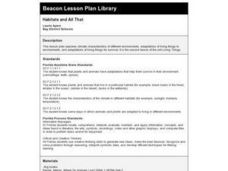Curated OER
Why Polar Bears Are White
Students are introduced to the concept of camouflage and protective coloration as well as Arctic animals. They examine how color can help animals in the wild. Students discuss where polar bears live and why they are white.
Curated OER
Keeping Warm When it is Cold: How does a polar bear keep warm?
Students make a model of a polar bear and discuss why fur/skin color is important. They also perform a simple experiment using black and white socks to determine how color affects temperature.
Curated OER
Goldilocks and the Real Bears
Students participate in a comparison lesson where they compare fictional bears to real life bears. In this science/language arts lesson, students read Goldilocks and the Three Bears. Students observe characteristics...
Curated OER
Polar Pals: Polar Bears & Penguins
First graders complete a variety of activities about polar bears and penguins including the "Blubber Mitten" experiment. They culminate the unit by creating a visual representation comparing and contrasting the two animals.
Curated OER
Which Bear?
Students study bears. In this science lesson plan, students compare black, grizzly and polar bears. Students measure the bear tracks and compare the bear habitats and diet.
Curated OER
Global Warming
First graders discover the effects of global warming on polar bears. In this life science lesson, 1st graders model the polar bear's habitat and observe what happens as they raise the temperature. They record their observation in the...
Curated OER
Take Your Pick of "Beary" Fun Activities.
Students complete an integrated unit on bears. They read numerous books about bears, create a bear puppet, act-out stories, create a polar bear painting, participate in a Teddy Bear Picnic, and conduct a Teddy Bear parade.
Macmillan Education
Happy 40th Birthday Brown Bear
What do you see? Wish a happy birthday to Bill Martin Jr. and Eric Carle's Brown Bear, Brown Bear, What Do You See? The lesson includes six extension activities for the books and its companion stories, including a maze and...
Curated OER
Sense of Hearing
Students explore the sense of hearing. In this human biology lesson, students listen to the story Polar Bear, Polar Bear, What Do You Hear? and give examples of how they use their sense of hearing everyday. Students pass around plastic...
Curated OER
Insulation and Buoyancy
Students predict whether their hands be warmer in ice water with or without a blubber mitten. They construct a blubber mitten using plastic, Crisco and compare their results with a control group. They observe how this affects buoyancy too.
Curated OER
A Day in a Life of an Arctic/Antarctic Animal
Students, through video segments, explore what types of animals live in the Arctic and Antarctica. They also clear up any misconceptions they have about penguins or polar bears.
Curated OER
Animal Matching File Folder Activity
In this matching worksheet, students match the picture of the animal that is shown on the left with the correct name on the right. They complete two pages with 5 matches on each.
Bulgarian Creative Writing Competition
Creative Writing Prompts For Every Season and Month
Winter, spring, summer, and fall! Every season is covered in a 14-page list of writing prompts. Included are story starters, reflection questions, poetry topics, and more.
Curated OER
Create a Food Chain
Students discover the connection between plants and animals by discussing simple food chains. Students explore what may happen when parts of a food chain are removed. Students wrap up the lesson by writing a story about a food chain.
Curated OER
Winter Holiday Activities Extravaganza
Learners define culture and explore elements that are part of the custom or culture of a place. In this holiday lesson, students identify the cultures they participate in. Learners identify the differences in people's...
Curated OER
Stay Away Tooth Decay
Students discuss what is meant by good dental hygiene. They identify food and drinks that are good and bad for their teeth. They use an egg to represent their teeth and place it in a dark liquid overnight. They predict what will happen...
Curated OER
Tundra Swan Fun Facts
Students read about the characteristics of tundra swan. In this tundra swan lesson, students understand the characteristics of the tundra swan and complete worksheets related to the tundra swan.
Curated OER
Earth Day - Bursting Beans
Students fill jars with dried beans and water, cover the jars, and wait to see what happens in this excellent Science experiment ideal for Earth Day (April 22nd). Emphasis is placed on discovering the reactions of seeds to water.
Curated OER
Habitats and All That
First graders read books, complete online explorations and discuss the ways in which animals adapt to their habitats in order to survive. They create accordion books, play matching games and dramatize animal adaptations.
Alabama Learning Exchange
Alex: Three Awesome Bears
The lesson will be implemented during a study of bears. Books, class discussions, and the Internet will be used to learn about bears and their characteristics. Black, brown, and polar bears will be categorized according to their food and...





















